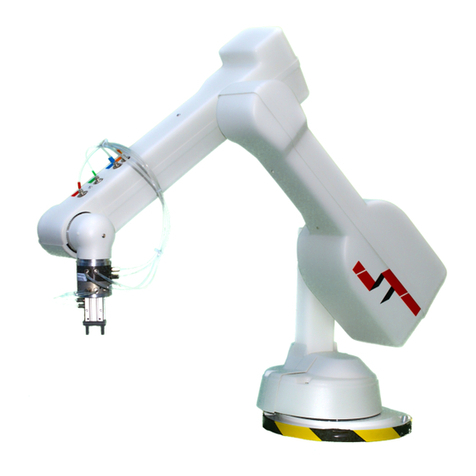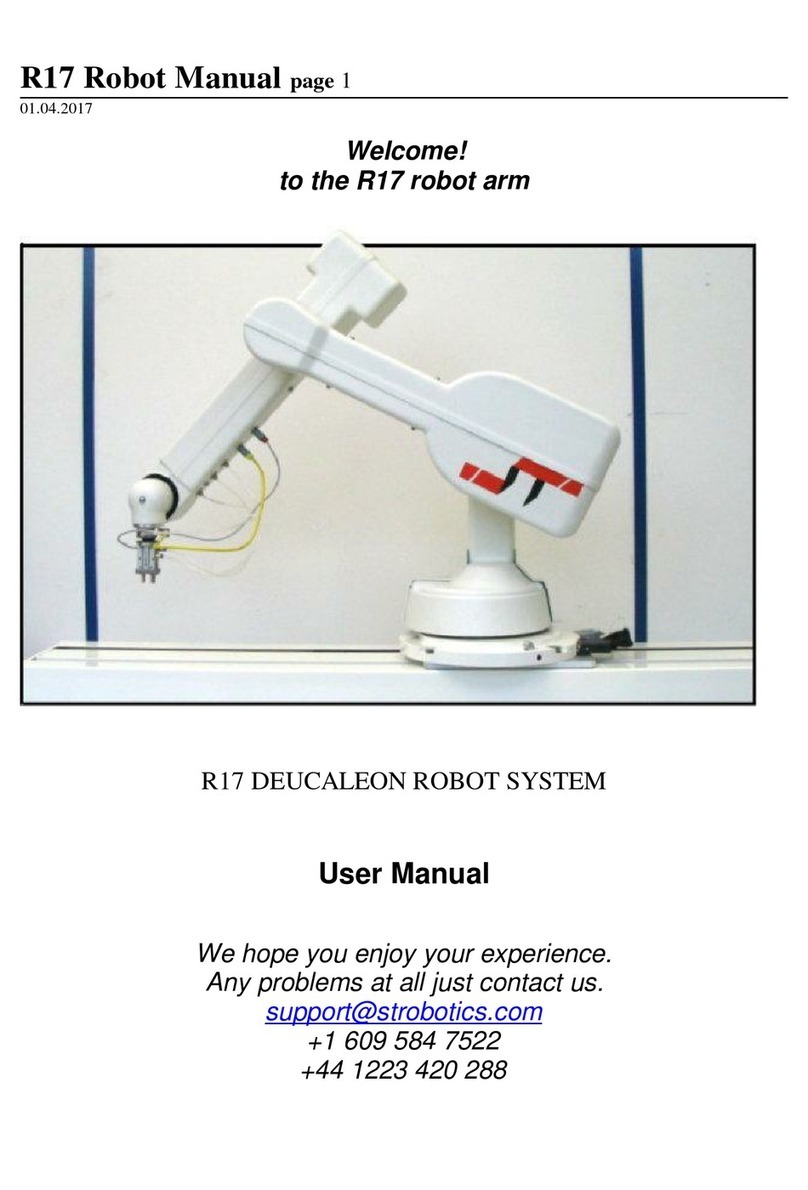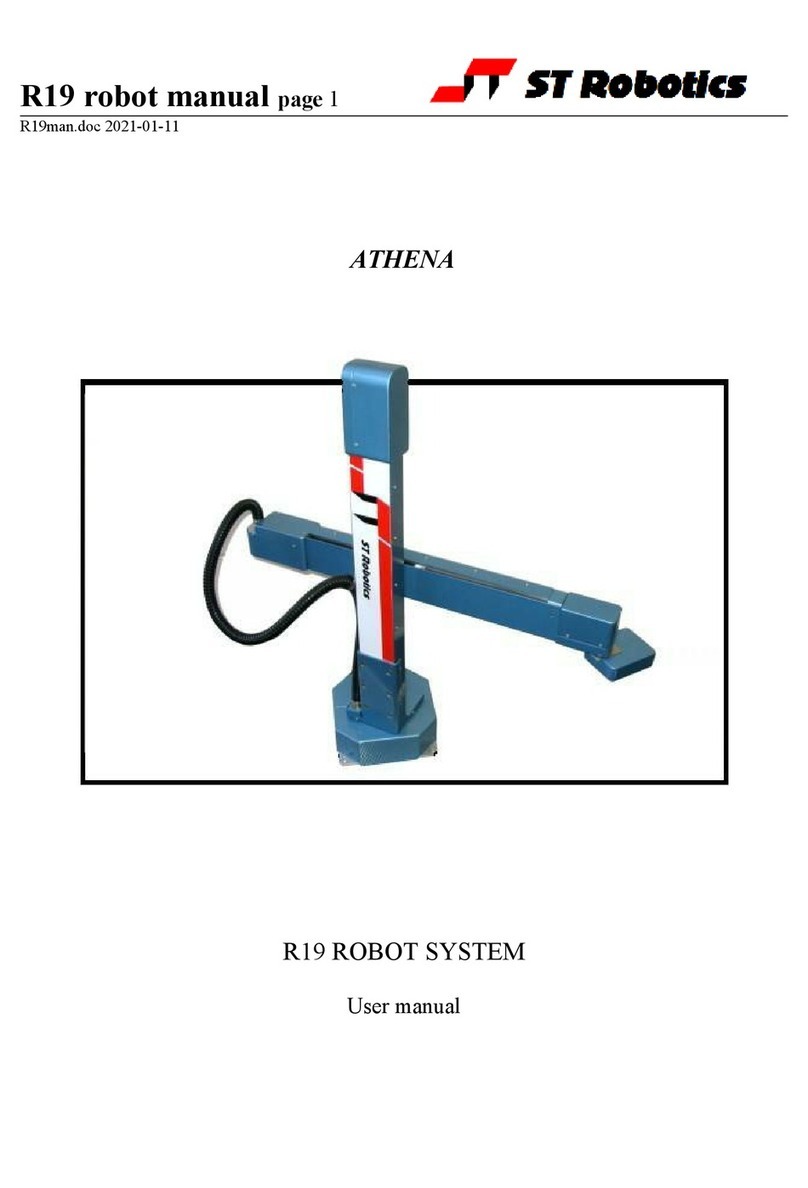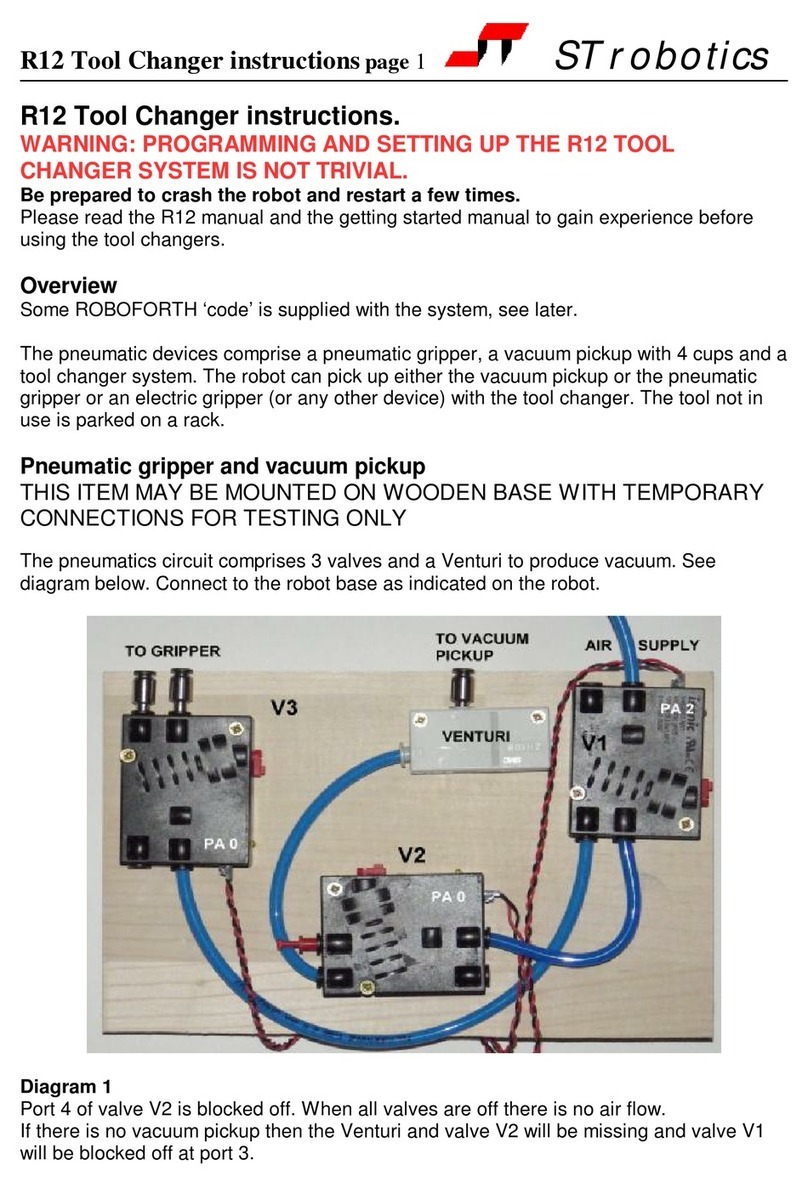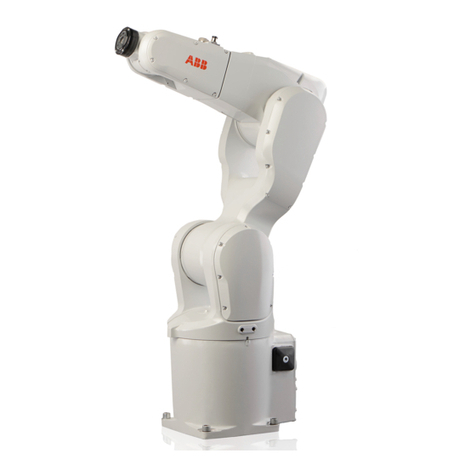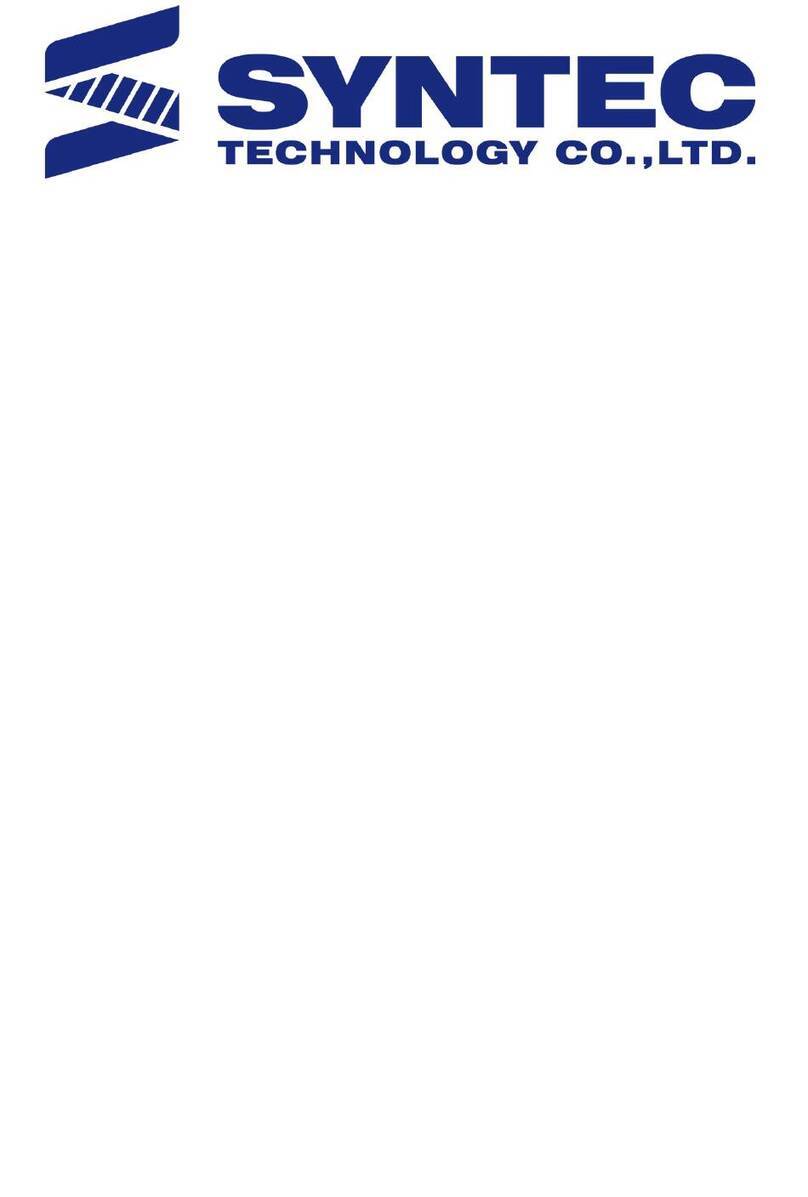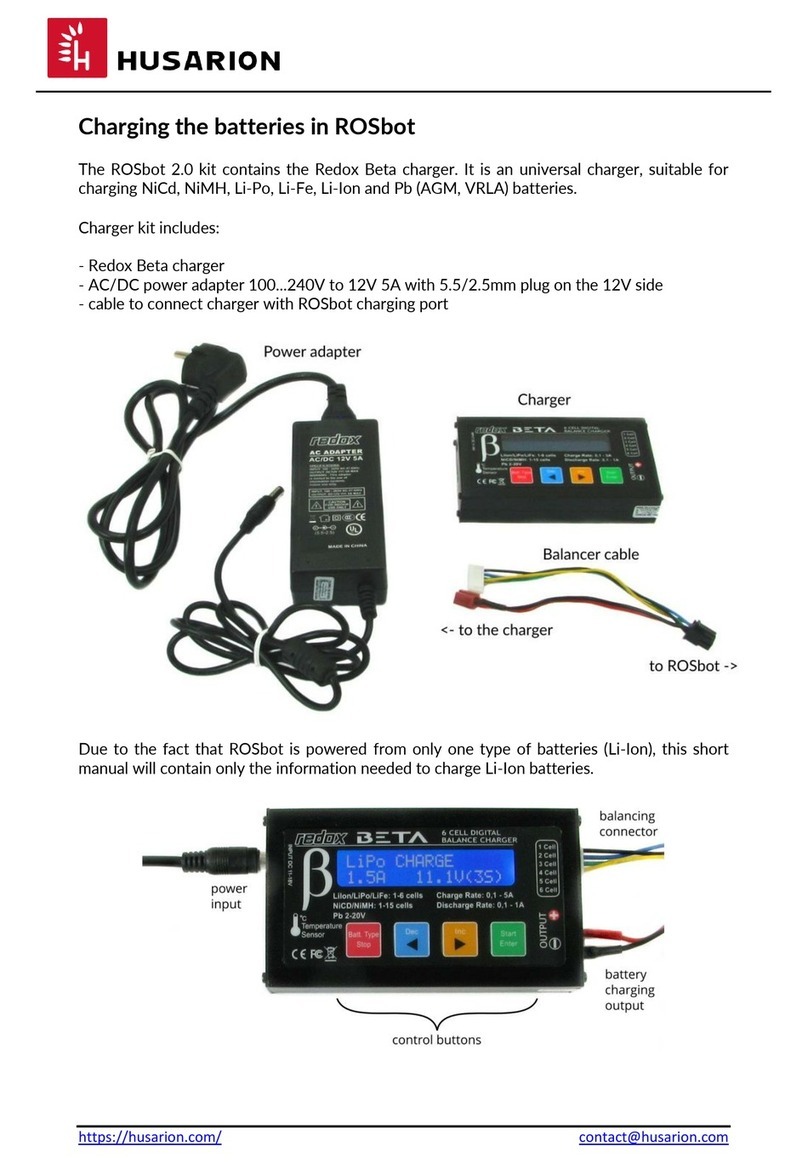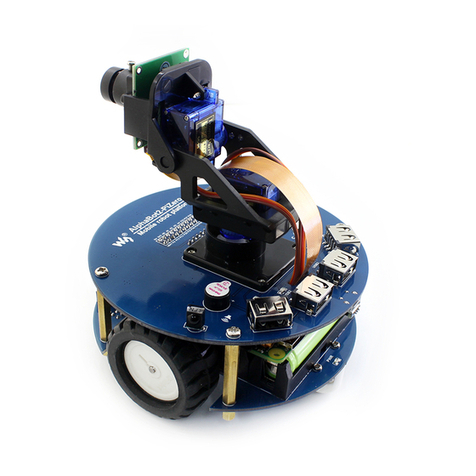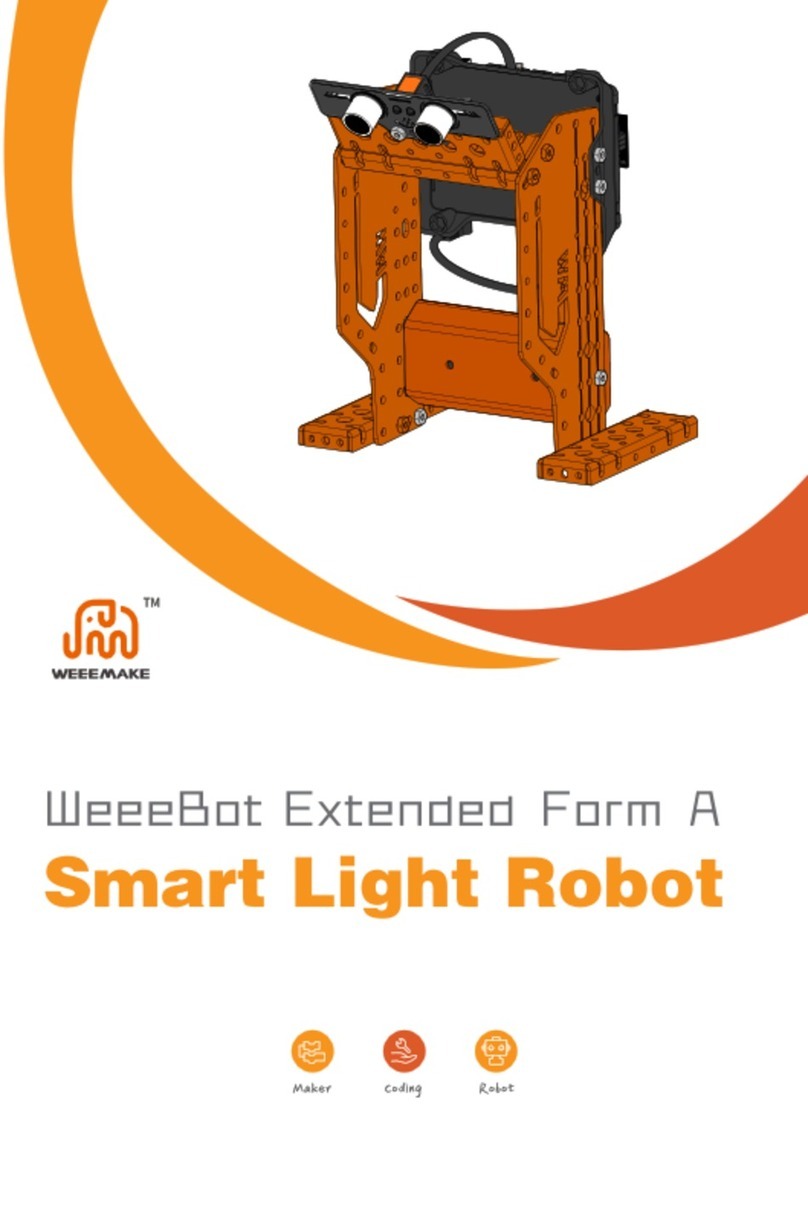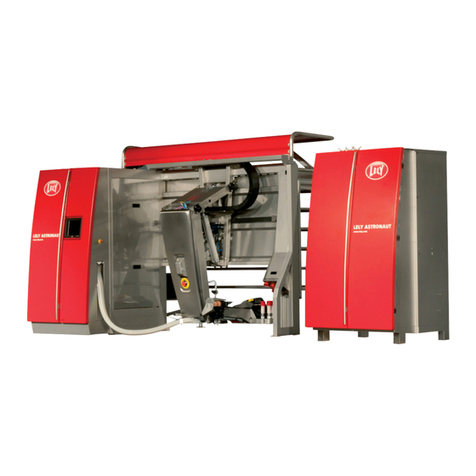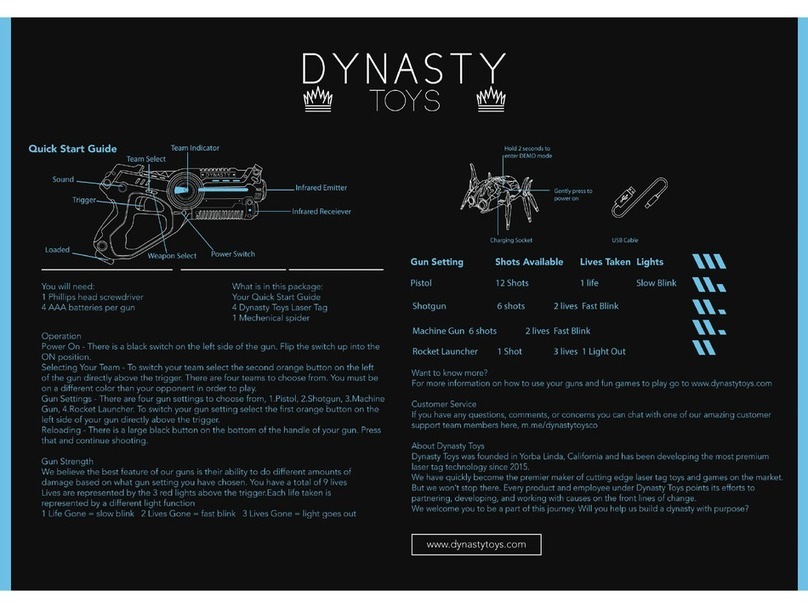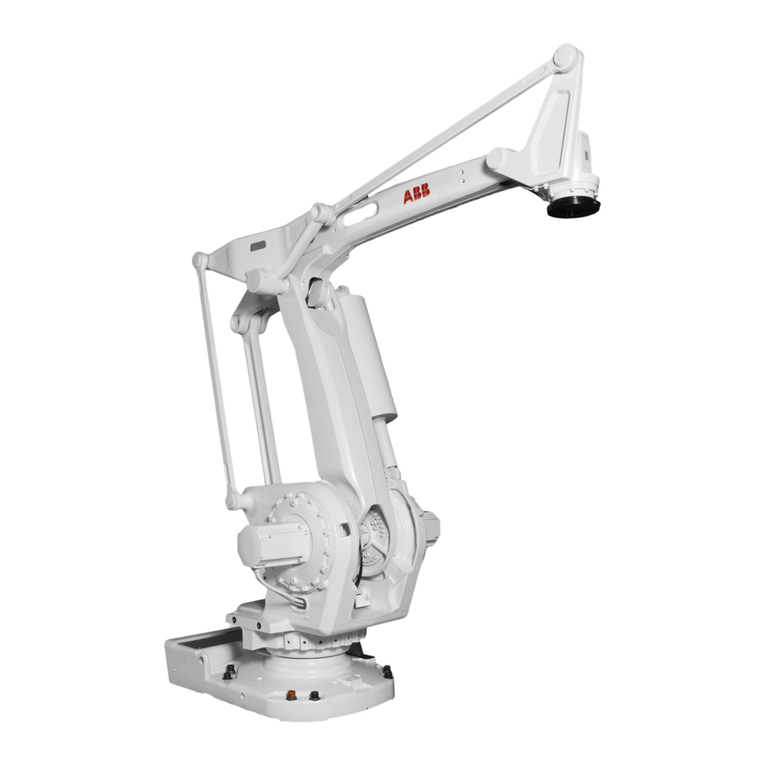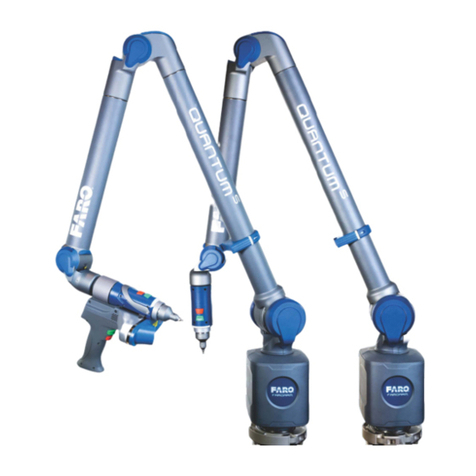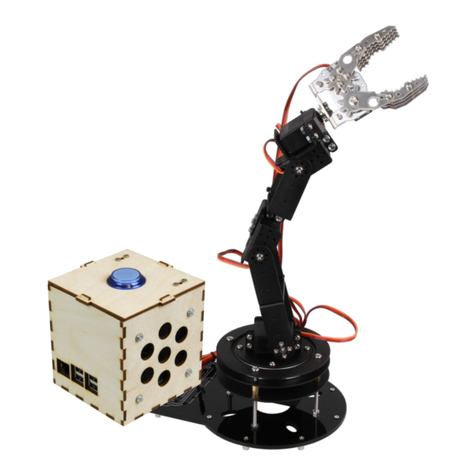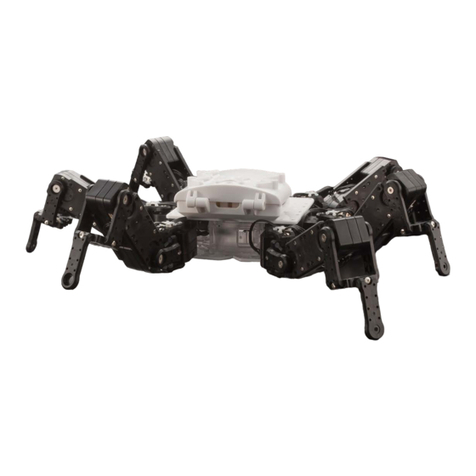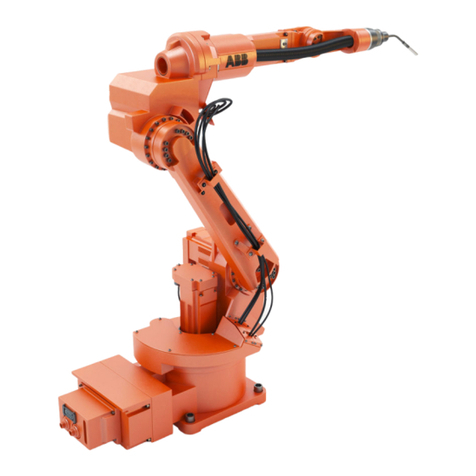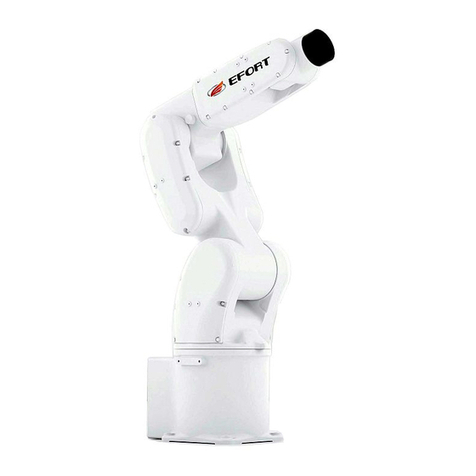ST Robotics R12-500 User manual

R12 Robot Manual page 1
01.04.2017
Welcome!
to the R12-500 Firefly robot arm
User Manual
We hope you enjoy your experience.
Any problems at all just contact us.
+1 609 584 522
+44 1223 420 288

R12 Robot Manual page 2
System Components:
A basic R12 robot system comprises the following:-
1 R12 Robot arm
Fitted with any options:
Pneumatic or electric gripper
Vacuum pickup
ncremental encoders
6th axis module
1 Controller K11R
Fitted with any options:
/O expansion
Gripper drive module
1 Teach box
1 Cable 9-way D-type each end (M-M) - K11R to teach box
1 Motor cable - K11R MS connector to robot 25-way D-type
1 Sensor and encoder cable - 25-way each end (M-F)
1 Cable, D-type 25-way male to 9-way female - K11R to PC RS232
1 Power cable to K11R
1 Pack of CONNECTORS:
1 output connector
1 input connector
1 Disk with software and manuals.
1 optional USB/serial adaptor
1 optional Android teach console.
1 Gripper pneumatics kit
Manual Contents:
1 ntroduction
2 mportant Dos and Don'ts
3 Setting up
4 Computer
5 Controller
6 Preparing for Use
7 Getting Started
8 Accessories
9 Controller Settings
10 Robot Parameters
11 Calibration and full calibration from scratch
12 Connections
13 Collisions
14 Technical Support

R12 Robot Manual page 3
1. INTRODUCTION
The R12, firefly is a revolute robot arm of the vertically articulated format. This is the format
which most closely resembles the human arm and so its parts are named after the human
arm. t is more versatile than other formats but the drawback is that backlash and compliance
in each joint are added together joint by joint. Firefly has a nominal reach of 500mm i.e. it is
500 mm from the shoulder joint to the wrist, plus another 100 mm or so for the hand,
depending on the "end effector" fitted. Firefly is driven by stepping motors in micro steps of
0.18 degrees per step resulting after gearing in a nominal resolution of 0.1mm or better at the
end effector. f fitted the pneumatic gripper is operated by compressed air from 3 to 7 bar.
This may be supplied by a compressor supplied with the set, or from another air supply.
The R12 robot system comprises 3 main units:- the robot, the controller, the user supplied
computer or terminal. The computer is used to program the controller. Once programmed the
controller will run the robot independently without the need for the terminal or computer but it
is a good idea to leave a low cost terminal connected while the robot is in use.
OVERVIEW
The controller controls all movement of the robot. As the controller may be both reading
sensors and signals from and controlling associated equipment it follows that all decisions
about robot activity are usually made by the controller which is capable of running without
any host computer. The function of the computer is to (a) program the controller, (b) to copy
(back up) the contents of controller RAM to disk and optionally (c) to perform a supervisory
role sending commands to the controller through the RS232 interface. The function of a
terminal is to display information or questions and for the operator to enter answers or
commands (e.g. part type selection).
To program the controller with a computer you need to run the utility ROBW N.EXE. When
ROBW N is executed it immediately opens a communications window. Once communication
is established all your commands go to the controller not to the computer you are typing on.
Programming the controller involves programming the robot and the interaction with other
equipment. The robot and interfacing are programmed using ROBOFORTH © and FORTH.
There are two manuals, ROBOFORTH covering robot programming and the system manual,
which describes the controller and interfacing. The software manuals are on disk and written
in HTML so you can use dynamic links to see connected concepts. There is also a glossary
on disk, which gives a brief description of every command. Some commands are used only
by ROBW N or are not very useful and these are in the glossary but not in the ROBOFORTH
manual.
All FORTH and ROBOFORTH commands are in UPPER CASE (press caps lock). You can
add commands written in lower case but these would be different commands from those
spelled in upper case.
RoboForth is copyright David N Sands

R12 Robot Manual page 4
2. IMPORT NT DOS ND DON'TS
(1) HANDL NG – DO take care when carrying the robot by hand or moving the arm by hand.
DON’T push the covers in when handling – this can damage wiring under the covers.
(2) DANGER - HOT – DON’T touch any of the motors. They can reach temperatures
approaching boiling point or more.
(3) DON'T ever disconnect or connect the robot while the controller is switched on. This will
result in damage to the connectors. Warranty claims will not be accepted for damage
resulting from this.
(4) DON'T back-drive the 6th axis; damage can result. Warranty claims will not be accepted
for damage resulting from this.
(5) DO be very careful not to "crash" i.e. drive any joint against a solid object so that it stalls.
Depending on the speed damage may result. At lower speeds the motors generate higher
torques so can do more damage. Avoid driving the waist against the stop.
(6) For the above reason DON’T use CAL BRATE unless you are sure the robot will not
crash into something in the workspace OR into itself, including taking into account any
complex end effector fitted.
(7) DO have your hand poised over the emergency stop button whenever testing a program.
Remember that because of its geometry a revolute arm will describe wide arcs from far apart
points, and may collide with objects within its reach.
(8) DO take appropriate measures to assess the risks and protect personnel from injury (see
next section)
(9) DON'T remove an object from an electric gripper by hand when it is gripping the object. t
may snap shut and damage the mechanism. Warranty claims will not be accepted for
damage resulting from this.
(10) DO read the section on the electric gripper before you use it.
(11) DON’T leave the robot switched on but not moving for very long periods of time (say
more than a week) as motor heat can damage the belts.
(12) DON’T try to save a project if the controller is switched off.
(13) DO make a back-up of the computer disk supplied as soon as possible.
(14) DO warm up the robot for best repeatability. After switching on from cold run the robot
some simple routine for 10-20 minutes. See note (2).

R12 Robot Manual page 5
S FETY IS YOUR RESPONSIBILITY
Hazards
Because stepping motors raise more torque at low speeds a substantial low speed force can
be brought to bear especially on fingers which may become trapped under or between axes.
Robot end effectors typically have sharp edges or fingers made of thin metal which can
cause injury at the low speed high forces or at the higher speeds.
The biggest risk comes from the element of surprise. f the system is active and receives a
command from a supervising scheduler or a signal from an associated machine the robot will
appear to move unpredictably. A human being caught in the way can receive injury. R12 is
not particularly powerful but can still cause a minor injury especially if the end effector has a
sharp edge.
However, because the robot is stepper motor driven, once stalled the system raises an error
and does not attempt further motion.
Also do not touch any motors once the robot is powered up as they get very hot. At hottest
they will approach boiling point.
Safety measures
f possible a robot system should be guarded. Any gate in the guarding can be fitted
with a switch, which is connected to the controller stop circuit. Another alternative is a
light curtain, easily connected to the robot controller
Guarding is not always possible and where bench-top robots work closely with human
workers interlocks can be provided. For example if the user has access to the
workspace then he/she could be required to press a switch or keyboard key after
clearing the area.
A good rule is that the robot should not be allowed to move outside an area
designated by the edge of the bench on which it is mounted.
Alternatively the working area should be marked out with painted lines or black/yellow
striped tape as an awareness barrier.
Statistically the highest incidence of contention between human and robot is when
both are accessing the same object. End effectors often have sharp edges which can
cause injury. Fitting a collision sensor can minimize this hazard.
At the end of this manual you will find a form with which to do your own risk
assessment of the robot in your application. There are two concepts to consider:
hazard, which is the robot or robot fingers or the product etc. and risk, which is the
probability of someone being harmed by the hazard. The form enables you to identify
the hazards, the risks and ways of minimizing the risks. After completing the form and
carrying out any safety measures that the form has helped you identify, do the
assessment all over again.

R12 Robot Manual page 6
3. SETTING UP
Set the robot up in the desired location. Connect up all cables - their positions should be self-
evident. Cables to the robot connect to the rear of the controller.
There are 5 basic cables:
Motor power – the metalized cable from rear of controller to robot base, 26wMS to 25wD
Sensor cable – from rear of controller to robot base (25wD male to 25wD female)
Gripper cable (if supplied) - from rear of controller to gripper valve (9wD to D N)
Serial cable – from front of controller to computer (usually 25wD male to 9wD fem)
or USB adaptor
Teach pad cable – from front of controller to teach pad (9wD to 9wD male to male).
There is also a Stop Jack for connecting an external stop circuit. Even if there is no external
stop circuit the jackplug must be plugged in at the rear of the controller. The plug has a
shorting link, which is removed when connecting an external circuit.
The serial (RS232 null modem) cable from a computer to the controller should plug into the
25-way D connector on the front of the controller. The other end (usually 9wD) connects to
the rear COM1 serial connector of the computer or USB adaptor (see later for configuration).
f COM1 is already in use you can use any other COM port. f a USB serial adaptor is used
this can connect directly between a computer USB port and the controller or the cable may
be used to extend the adaptor.
DOS utilities only work with COM1.
Pneumatic connections
Connect the air line by pushing it into the push-fit connectors on the air valve and two from
the valve to the rear of the robot. f there is no compressor supplied then connect the shop air
supply to the air valve. The air supply must have a bowl filter and a pressure regulator.
Pneumatic gripper
f a pneumatic gripper is fitted the robot will have two airlines fitted through it, emerging on
the forearm. Two external lines loop to the gripper. The control valve is external. The valve is
operated from output port PA bit 0.
Electric gripper
This is powered and controlled from the robot controller and all wires run through the cables
and robot arm. The gripper drive module uses both PA 0 and PA 1 so PA 1 should not be
used for any other purpose.
Vacuum pickup
f a vacuum pickup is fitted the robot will have one airline fitted through it, emerging on the
forearm, looped to the pickup. f you have both gripper and vacuum there will be 3 airlines. A
separate valve connected to PA 2 selects gripper or vacuum.
f you change from one tool type to another see help sheet 23.
See more detailed information in section 8.

R12 Robot Manual page 7
4. COMPUTER
Note: Commands to computer or controller are in the form of a string of characters followed
by the enter key. n all my examples of dialog between man and machine will underline text
typed in by the user. won't keep mentioning the need for the enter key. A machine response
will be in upper case but not underlined. My comments will be in lower case.
Before switching on the controller switch on the terminal or computer and proceed as
follows:-
1. Create a directory (folder) ROBOT on C: drive
2. Copy all the files to your ROBOT directory
3. f you have a USB-serial converter first install its software. t should install itself as
most versions of Windows have the FTD driver already included.
4. Plug in the USB converter and use either the serial cable or the adaptor to connect to
the controller. Windows 7 will probably want to go online for the drivers, select skip for
both drivers, USB serial converter and USB serial port. Once installed it should tell you
what port number it has selected. f less than 10 then skip step 5.
5. f you are not told what the COM number is you will need to find out. Go to control
panel, system, hardware, device manager, ports. You will see USB serial port - note
the port COM number.
6. RobWin will only work up to com9 so if your converter has been mapped to higher
than com9 then double-click that port, then go to settings, advanced. You will see
COM Port Number click the drop-down. You might see a lot of COM ports marked "in
use". t's usually incorrect unless in use by bluetooth. Pick com3 anyway (or next
available after bluetooth) up to 9 as indicated in the device manager). t will say it's in
use do you want to continue, click Yes.
Whatever com number you choose, make a note.
7. Find robwin7.1.14.msi (or later) and install RobWin 7. You may also use earlier
versions robwin6x.exe on the CD
8. Double-click robwin.exe to run.
9. RobWin defaults to COM1. f you have a computer with a regular serial port and have
been supplied with a 25/9 modem cable then COM 1 is correct. But for a USB COM
port change to the active com port (see 6 above). Click comm at the top, then
configure and make that the same number. Baud rate should be 19200.
10.Click Settings, Open file then enter R12R17.cfg
For the 6-axis versions enter R12R17-6.cfg
You are now ready to use RobWin7.

R12 Robot Manual page 8
5. POWERING UP THE CONTROLLER
To power up the controller, connect the power cord at the rear and operate the power switch,
which is integral with the power connector. You may have all other cables disconnected if you
wish. However be sure to turn off the power before you connect any rear cable, especially
the motor cable. When power is switched on the front TX light should flash which means it
has sent the opening message to the computer. You should see that in the communications
window of ROBW N. f the light flashes but nothing appears on the screen then this indicates
a problem with the computer. Try clicking comms and select another COM port. f you have a
USB-serial converter make sure the COM port selected matches the port shown in the device
manager. Also make sure the baud rate is 19200.
The Mk5 controller CPU has Flash ROM and static RAM on the same PCB. Cold/warm/start
selection is a front panel key switch. The memory image is in flash ROM which is loaded to
RAM when you power up (or press reset). When powering up for the first time select COLD
start before you switch on. You will see a herald on screen that should include the words
COLD START.
Front panel designations:
FA L: indicates power supply problem e.g. low mains voltage. When power is turned on it
stays lit until power supply is secure. Also lights when reset is pressed.
OK: opposite of fail, indicates good power supply.
TX: lights when serial data is passing from controller to computer
RX: lights when serial data is passing from computer to controller
STOP: stops robot motion (provided CPU is in control – see software manual)
RESET: resets CPU, DSP and other logic.
TEACH: teach pad input
COLD/WARM/AUTO switch – selects start-up mode when power is turned on or reset is
pressed. (see section 7)
RS232 – connects to computer.
Note: if neither FA L nor OK are on the rear 12v fuse may be blown.

R12 Robot Manual page 9
f there is no message on screen press the reset button on the front panel and watch the
lights. The red led should light as you press the button. As you release the button the red led
goes out, the green light comes on and the yellow TX light should flash. f it flashes the
controller has sent characters up to the computer. Check the screen. f there is nothing there
check com port and baud rate.
Assuming you have the herald press the enter key and you should see
> OK
Press caps lock and you should now be able to type commands into the communications
window, see later.
Rear Fuses
Viewed from the rear of the controller from right to left:
Power connector has 2 fuses. These should be 6.5A anti-surge for 110v power and 3.5A ant-
surge for 220-240 power.
12v unregulated DC fuse. This should be 3 amp quick blow. The 5v logic (and lower) all
comes from the 12v regulated supply so if this fuse blows the whole controller is dead.
This supply emerges from the 9 way input and 15 way output connectors for users
sensors etc so if you are blowing 12v fuses the fault would be there.
24v unregulated DC fuse. 24v is an alternative for users external circuitry as most industrial
contactors etc are all 24v DC. Pneumatic valves can be 12v or 24v. The robot LEDs are
powered from 24v. To extinguish the LEDs remove this fuse OR to disable permanently
open the controller and remove the connector inside the rear of the cabinet. This is
identified as a single red wire into a blue HE14 connector – simply pull it off. Removing
the 24v fuse disables all 24v items such as 6th axis or electric gripper.
Stop Jack
Also on the rear panel is a jack plug. This is for the external stop circuit and has it’s terminals
linked inside the plug. f the jack plug is removed the robot will not run.

R12 Robot Manual page 10
6. PREP RING FOR USE
Switch off the controller and set the robot up visually to an approximate home position (see
below). This is the only position from which you can calibrate the robot.
5-axis home 6-axis home
(hand points backwards)

R12 Robot Manual page 11
Optional: Check that sensors and encoders are working.
1. Connect up the sensor/encoder cable to the robot – this is the cable with a 25w D each
end. Do not connect the screened (braided sheath) cable at this time. Switch on the
controller.
2. Enter the following:
ROBOFORTH <enter>
This invokes the RoboForth dictionary. This is only necessary after a cold start and you need
to type it every time you switch on if the key is set to ‘cold’.
START <enter>
ENCTEST <enter>
A row of numbers appears.As you move each joint by hand the numbers will change. This
shows the encoders are working. Press escape key to exit this mode.
128 -3041 0 0 0 0 (example)
3. Enter PP <enter>
A row of 1s and 0s appears. nitially this should be
11111110
These represent the calibration sensors on the robot. Set the robot up in an approximate
home position, which is with the arms bolt upright. From right to left the digits are: waist,
shoulder, elbow, left hand, wrist.
4. Now move the joints very slowly towards the sensors which could be in either direction but
not more than 10-20 degrees from the home position. Do this slowly because the sensor
positions themselves are only 1-2 degrees wide and you can easily go past them without it
registering in the PP. As you move into or out of a sensor position a 0 will change to 1 or a 1
will change to 0 with a beep. As long as you can find some sensors (waist is easiest) that will
confirm they are working. For example if you move the waist counter-clockwise to its sensor
you will see:
11111110 change to 11111111 then back to 11111110
f you then move the shoulder to its sensor you will see:
11111100
Or if you then move the elbow to its sensor you will see:
11111010
Press escape to exit the PP command.
5. You are now ready to connect the motors. SW TCH OFF THE POWER F RST and wait 10
seconds before connecting the motor cable from controller to robot.
Note: with the motor cable connected you can still check the encoders or sensors, enter
DE-ENERG ZE <enter>

R12 Robot Manual page 12
7. GETTING ST RTED
WARN NG
Before trying any of the following commands be sure to
KEEP OUT OF THE ROBOT ENVELOPE
Note: LL FORTH and ROBOFORTH COMM NDS RE IN UPPER C SE.
First checks
Assuming RobWin is loaded and running:
1. Press caps lock and you should now be able to type ROBOFORTH commands into the
communications window.
2. Type
ROBOFORTH <enter>
(if the key was set to ‘cold’)
3. n the communications window type
START <enter> or click the button
A herald will appear announcing ROBOFORTH and it’s version.
Even though you have not yet calibrated the arm you can check out the axes with the teach
pad.
4. To start moving the arm click the button or type
TEACH then press <enter> two times. gnore any “FN=” message.
The red “TEACH” and green “ON” lights should be on.
With this method pressing a key on the teach box moves the arm.
Since you might let go of the key at any time and expect the robot to
stop it is not possible to accelerate to high speed. Moreover a slow
speed is more desirable to achieve precision, and the teach speed is
requested after you enter TEACH. At this stage just hit the return key.
After you enter TEACH or click the button you are now in "TEACH
mode". To move the arm first select the joint to move, J1 for waist, J2
for shoulder, J3 for elbow, J4 for hand, J5 for wrist twist. On selecting a
joint the terminal/computer will beep. Then press either + or - for motion
in a positive or negative direction.
6-axis version: J4 for pitch, J5 for yaw, J6 for
roll (gripper rotate) f the robot is on a track
then J6 is the track.
Note: J4 is actually 2 motors driving each side of a differential. The gear ratio for each side is
slightly different and J5 will seem to move slightly also. This is not a fault. Simply use J5 to
correct the angle.
J1
J2
J3
J4
J5

R12 Robot Manual page 13
To operate the gripper press the key marked 'GR P', then to close the gripper press the +
key and to open the gripper press the - key. f you have an electric gripper do not operate it
yet. Please read the section on electric gripper first. Do not try other keys for the moment.
Use TEACH mode to test all the joints and finally drive the robot to an approximate home
position. Exit TEACH mode by pressing the escape (ESC) key on the computer/terminal.
5. Next the robot should be calibrated. First of all enter:
DE-ENERG ZE (or DE-ENERG SE)
so that you can move the robot by hand to an approximate home position. This is with the
robot bolt upright and the waist rotation at about mid way. Make sure the wrist/hand is upright
with any hoses in the most free position. Enter
START then CAL BRATE
The robot begins to move as it searches for internal sensors. No axis will move particularly
far. f you see an axis move more than 30 degrees something is wrong; press the stop
button. Check cables; check the starting home position, repeat from above. CAL BRATE
drives all the joints to the proximity detectors and corrects the counts. The robot then returns
to the HOME position. All counts will then be zero.
The axes calibrate one at a time in the order 1 2 3 5 4 6. Each axis has a maximum number
of counts allowed to find its sensor, (the absolute value in L M TS plus another 1000).
f the count exceeds this you will get a “too far to sensor” error. f this happens it is usually ok
to just enter CAL BRATE again.
6. Enter
READY
drives the whole arm to a useful CARTES AN position ready for use.
HOME
drives the whole arm back to the home position.
lternative calibration where headroom is restricted.
f requested on your order the robot can calibrate to a position where the elbow is approx 90
degrees to vertical. The starting position for the elbow should be aprox 70 degrees to vertical.
Type
START then CALX
The robot will seek out sensors in this special position. Once complete the robot will be
calibrated correctly but does not automatically go HOME
However you can go directly from this position to READY or any other position previously
programmed.

R12 Robot Manual page 14
8. END EFFECTORS
Pneumatic Gripper connections
f the gripper opens when it should close and vice versa simply swap over the two 4mm tubes
at one end.

R12 Robot Manual page 15
Vacuum pick-up connections:
Change from gripper to vacuum:
There will be a total of 3 valves. One for the gripper as above and one for the vacuum as
above. Both these valves connect to PA 0 so the command GR P will operate either of them.
A third valve is provided to switch between the two, connected to PA 2.
So to operate the pneumatic gripper PA 2 should be OFF, just enter GR P and UNGR P.
To operate the vacuum use
PA 2 ON then GRIP or UNGRIP
Programming the optional vacuum sensor:
The vacuum switch is connected to PB 6. You can quickly check this with
GRIPCHECK
nsert this word at a suitable place for the robot to check it has a valid pick e.g.
JIG GRIP WITHDRAW GRIPCHECK
f there is no vacuum (object not picked) you will get “Grip fail” error.
djusting the vacuum sensor.
t has already been set at the factory but you can adjust as follows:
1. type GR P (remember that this consumes a great deal of air and you may need to
UNGR P then allow the compressor to recharge before trying again.
2. Type PP to display the input port. You should see 11111111
3. Adjust the sensor using the 1.5mm Allen key supplied until you see 11011111 then
back off again until you see 11111111.
4. Cover the vacuum cups and the display should change back to 11011111

R12 Robot Manual page 16
Tool changer or multiple tools
Note that an electric gripper uses PA 0 and1 in PWM mode to open the gripper.
To change between electric gripper and pneumatic gripper:
Enter
1 GTYPE ! for electric gripper
0 GTYPE ! for pneumatic gripper
f the vacuum is connected to some other bit, not PA 0 enter the bit number for GTYPE
For example 4 GTYPE ! if the valve is connected to PA 4.
f you have both electric gripper and vacuum then the vacuum valve should normally be on
PA 2 not 0. GR P and UNGR P then operate the valve labeled in the above picture as V2
f you have a tool changer please see the separate R12 tool changer guide.

R12 Robot Manual page 17
Electric gripper
f the electric gripper is fitted this is wired through the robot and requires no installation by the
customer but there is an external cable from the arm to the gripper. Take care not to
continuously rotate the gripper or the wire will trap or break.
Do not force the jaws of the gripper open or closed. Only use GR P and UNGR P
The gripper is operated by a drive module in the controller. A variable GTYPE contains the
value 0 for a pneumatic gripper and 1 for electric gripper.
Electric grippers are controlled from output port PA bits 0 and 1 but do not write to those bits
directly. Only use the commands GR P and UNGR P.
GR P puts PA 0 on. During closing PA 0 is switched on an off at approx 500Hz. Once closed
PA is left full on.
UNGR P asserts PA 0 off and PA 1 on again at 500Hz until the gripper is open then asserts
PA 1 off.
The time allowed for GR P and UNGR P is a value in TGR P in mSecs, usually 1000 mS.
E1 E2 EG12
E1 gripper is a fulcrum or scissors style operation supplied with sculpted fingers. t's normal
to glue some low friction material or foam to the inside of the fingers.
E2 is also fulcrum but has two 'jaws' with M4 screw holes. t is normal to make fingers to
match your product that screw on to these jaws.
The E2 is supplied with long screws to prevent over-closing. Without them the jasws could
over-close and jam. Just remove them when you fit your fingers.
f an E1 or E2 gripper becomes jammed at full travel remove it from the robot. On the
underside you will see two gearwheels. Turn these by hand.
EG12 is similar to the R17 EG17 with a rack and pinon mechanism resulting in parallel
motion of the jaws.
Never remove an object from the gripper by hand when it is gripping the object. The
jaws may snap shut and jam or damage the motor.
Increasing grip speed.
The 500Hz comes about because the power is off for 1000 uSecs and on for 1000uSecs.
The on time is determined by a variable TON (try TON ?) Change with <val> TON ! A bigger
value will result in faster closure. You can then reduce the value of TGR P.

R12 Robot Manual page 18
9. CONTROLLER SETTINGS
FL SH ROM
Cold start mode
When power is switched on, or the reset button is pressed all RAM contents are refreshed
from flash ROM. All the user programming, whether entered in immediate mode or using
RobWin will be lost.
After you see the herald and the words ‘cold start’ enter
ROBOFORTH
Warm start mode
f power goes off/on or the reset button is pressed all RAM contents are refreshed from flash
ROM including the user program area. Therefore your user program will be over-written with
any older program previously saved. To ensure that the new program is reloaded after a
power-up or reset type the command
USAVE
f you forget to do this and accidentally lose power or press reset (or are forced to press reset
because of a bug) then in RobW n click project, reload.
Default values
All the robot parameters revert to their original values when the controller is powered up or
the reset is pressed. f you wish to change any values and make them permanent there are
commands to write memory back to flash – see sections 10 and 11.
The robot parameters are also in the user area and any changes made (intentionally or
accidentally) will be saved to flash with USAVE. See section 11. The parameters include
calibration values, encoder ratios, constants required by the gripper.

R12 Robot Manual page 19
10. ROBOT P R METERS
W RNING – there should be no reason to alter these constants unless some
change has been made to the robot, for example a repair.
These parameters are particular to your robot, sometimes called a ‘signature’. They comprise
the calibration figures in L M TS, numbers of steps per 90 degrees of axis movement,
arithmetic relationships between encoders and motors, microstep ratios, and other constants.
Also in the signature file are the gear ratios, micro-step ratios and other parameters.
RAM memory is loaded from flash ROM on each power-up or reset. f you change something
you will need to update the flash ROM so test thoroughly before you do this.
Robot Calibration (homing)
When the robot calibrates it seeks out proximity detectors on each axis and corrects the
counts to values seen in the array L M TS which you can view with V EW L M TS
The accuracy of these figures affects the home position, and is particularly important in
Cartesian transformations i.e. calculations of joint positions from Cartesian coordinates.
Encoders
The encoders are fitted as watch-dogs not as feedback devices as such. After a move the
encoders are checked to see if the motor did what it is told. f the error is small a correction
may be made (see software manual) or if it is big then clearly some collision must have
occurred and the robot stops with ‘ENCODER-STEPPER M SMATCH’ and the axis number.
These are the conversion factors determined by the encoder resolution and the gear ratio
between motor and encoder. They are an array of 6 16-bit values located at ENCRAT OS.
Another array ENCTOLS holds the tolerances that an error must exceed before a mismatch
is announced. f ENCODER-STEPPER M SMATCH occurs unexpectedly see Help sheet 12.
Track/6th xis
The track or the 6th axis may be fitted but not both. The track has an encoder but the 6th axis
does not.
Micro-stepping
Each motor is ‘micro-stepped’ and the micro-step setting depends on the type of drive
module fitted in the controller. Geckos are set to 10 but the system may set different values
in order to software-gear each axis individually. There is an array M CROS which has the
values from 1 to 5 depending on the axis.

R12 Robot Manual page 20
Motors, gearing
The waist (rotate), shoulder and elbow joints are driven by 2-stack stepping motors, driving
through toothed belts. The ratios chosen are to obtain the desired resolution and the correct
load matching for the motors at high speeds. The R12 hand is driven by two motors. f both
run together then the hand will pitch but if motor 5 only runs then the hand will roll. However
the gear ratio for hand pitch is slightly different from wrist roll. As you pitch the hand using
commands or the teach pad you will observe it also rolls very slightly. This is not the case
when using Cartesian mode.
Gear ratios in parameters file.
The following constants are the motor counts for 90 degrees of joint movement:-
Joint: WA ST SHOULDER ELBOW L-HAND WR ST
Constant: B-RAT O S-RAT O E-RAT O W-RAT O T-RAT O
for 6-axis versions
Joint: WA ST SHOULDER ELBOW L-HAND R-HAND WR ST
Constant: B-RAT O S-RAT O E-RAT O W-RAT O T-RAT O R-RAT O
To print the current value enter e.g.
B-RATIO .
Energizing current
Although the high power motors will accept 4 amps we energize at less for two reasons: - (1)
at low speeds the torque at the final drive can be very high so the reduced current reduces
this torque for safety. (2) At a certain low speeds the rotor of a stepping motor can resonate
resulting in vibration. This effect is eliminated by reducing the current. This also reduces low
speed torque, which can be damaging when mistakes are made. Note that at high speeds
the current is not limited by the drive circuits, but by the time constants of the motors. n other
words high speed torque is not affected by reducing the quiescent current.
Driver currents are set by choosing resistor values from the following table.
IDE L GECKO MOTOR DRIVE CURRENT SETTINGS. RESISTOR V LS
XIS
NO.
JOINT N ME LOGIC
CH N.
MPS RESISTOR
V LUE
MICRO-
STEP
SETTINGS
V LUE
OF
MICROS
1 W IST 0 3.0 36k 10 4
2 SHOULDER 1 3.5 47K 10 2
3 ELBOW 2 3.5 47K 10 1
4 L-H ND 3 2.0 18k 10 1
5 WRIST or R-H ND 4 1.0 8.2k 10 1
6 WRIST 5 1.2 12k 10 1
Table of contents
Other ST Robotics Robotics manuals
